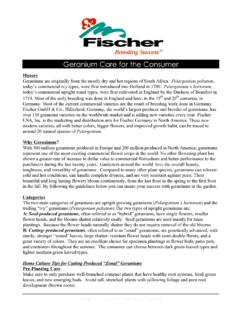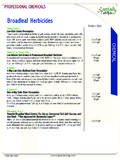Transcription of Insects of Trees, Shrubs, Annuals, and Perennials
1 HOME GROUNDS & ANIMALS 2009 Home Ornamentals: Insects of Trees and shrubs 4-23 Insects of Trees, shrubs , Annuals, and PerennialsEric R. Day, Extension Entomologist, Virginia TechPeter B. Schultz, Extension Entomologist, Hampton Roads ARECT hese recommendations are intended for the non-professional gardener. The more common pest species can be controlled safely and simply with a minimum number of pesticides. For complex or persistent problems and for large shade trees or expansive areas, it is wise and economical to engage the services of an experienced commercial arborist or custom spray and Significance of Pest ProblemsTwo frustrating problems with ornamentals are: 1) Knowing if, what, and when pesticides should be used on more than 100 dif-ferent plant genera, and 2) determining the identity and importance of any given pest found feeding on valuable and long-estab-lished trees and shrubs .
2 More than 2,000 species of Insects and mites may be encountered on woody plants. A great majority of these are uncommon, occasional, and pose little threat of serious damage to the plants, while about 15 percent are common, injuri-ous, and potentially destructive. One of the best reference books on the subject is The Gardener s Bug Book by Cynthia Westcott, which is unfortunately out of print. Insects that Feed on Trees and shrubs 2nd Ed Revised is an excellent resource and is currently aesthetic nature of prized ornamentals creates high values for individual plants. Therefore, even a minor or uncommon pest can be an important and costly problem for the owner if it is severe on only one or a few plants.
3 The average home gardener is familiar with very few of even the more important pests, thus each unfamiliar insect found feeding on valuable ornamentals creates uncer-tainty as to possible damage or loss of help identify pest problems, an index is provided listing the Insects and mites reported from more than 125 different kinds of ornamental plants. It is not feasible to list all of the specific pests. For example, 20-30 species of scale are known from camellia, 18-20 species from elm, and 20-24 species from oak. There are 22-25 species of borers known to attack oak, and 8-10 species of mites known to attack elm. In the index the pests are listed by type as groups or individuals.
4 Those of major importance which are common, injurious, and usually require control treatments are underscored. Those which are occasional, minor, have no known control, or for which control is unnecessary in usual situations are not underscored. For each important pest or pest group, control recommendations are suggested in Table I following the index. Table II provides directions for pests can be identified tentatively with a minimum knowledge of entomology. To use these recommendations for a given problem, look in the index under the host plant involved. By scanning the list, the appropriate group or pest usually can be found by knowing the difference between aphids, borers, leafhoppers, scale Insects , lacebugs, leafminers, defoliators, etc.
5 To further iden-tify pests and obtain details on life histories, habits, and precise timing for control measures, consult reference books and Virginia Cooperative Extension (VCE) publications. The most complex groups are scale Insects and borers. There is great variation in sea-sonal development patterns, and hence in timing the application of control measures. Extension agents and specialists at Virginia Tech can provide additional assistance on pest the Need for Control MeasuresApplying insecticides at the wrong time of year or when unnecessary may constitute a misuse of pesticides. In cases of serious common pests, it is important to apply control measures before populations become large.
6 Often, an insect infestation is found after it becomes intense and conspicuous. Then, in most cases, it is NOT the best time to apply control measures. Yet many people feel the urgency of taking remedial action immediately. Pesticides must be applied at the proper time to be effective. Frequently, it is unnecessary to apply sprays at all if the pest is minor and only present in small numbers. For numerous pests, especially gall Insects , there is no known control; spraying is not feasible. Finally, it is usually unnecessary to use insecticides after an infestation has peaked and begun to subside. Parasites and predators are often present and help reduce the remaining number of pests.
7 They can be favored by avoiding the use of pesticides. For common serious pests, application of chemicals early when populations are first getting established is most effective. Natural enemies are not adversely affected when the pest is controlled before the benefi-cial Insects appear. Remember that unnecessary or untimely applications may be considered as a serious MISUSE of pesticides. It is not a good policy to spray all plants simply because it seems like a good idea, nor to use more insecticide than specified on the label. Pesticides are essential to the preservation of plant materials which enhance man s environment where he lives and works.
8 Used as recommended they do much more to improve than upset it. Relatively few serious insect and mite pests of woody ornamen-tal plants can be controlled by other than chemical means. More and more, public demands and governmental regulations require minimizing the use of pesticides. Therefore, this guide recommends relatively few materials for use around the home. These are the least toxic in nature, exhibit the least potential threat to the environment, and are essential for effective results. However, certain pests may be more difficult to control, require more costly chemicals, and require more frequent use of other pesticides. Certified Applicators services should be utilized when GROUNDS & ANIMALS 20094-24 Home Ornamentals: Insects of Trees and ShrubsPesticide NamesThere are four ways to identify pesticide products: the chemical name; the accepted common name; the trade name; and the brand name.
9 Brand names (such as Bug-B-Gon) are capitalized and denote the manufacturer or distributor but do not indicate the chemical ingredients. Trade names (such as Sevin, Orthene, etc.) are capitalized and are trademark names for specific insec-ticides. Common names (such as carbaryl, dicofol, malathion, etc.) are coined names not capitalized, accepted by industry, sci-entists, and governmental agencies for specific insecticides. Chemical names for complex organic chemicals may be found on labels but are meaningless to the average user. It is essential to know which insecticides or miticides and what concentrations are in each pesticide formulation that is to be used for the desired and MiticidesIt is essential to use some residual insecticides to protect trees, shrubs , and turf.
10 Many destructive Insects emerge over an extended period of time or are highly mobile. Non-residual chemicals kill only those Insects contacted at the time of applica-tion. It is not feasible to spray diverse ornamentals frequently enough to protect them from many types of pests. Residual insec-ticides are highly effective for those species and are essential until suitable alternatives can be developed. Systemic insecticide-miticide materials are not recommended for the home gardener, except vary greatly in their properties. Malathion and diazinon on foliage remain toxic to Insects for a very short period, normally not exceeding one or two days.








